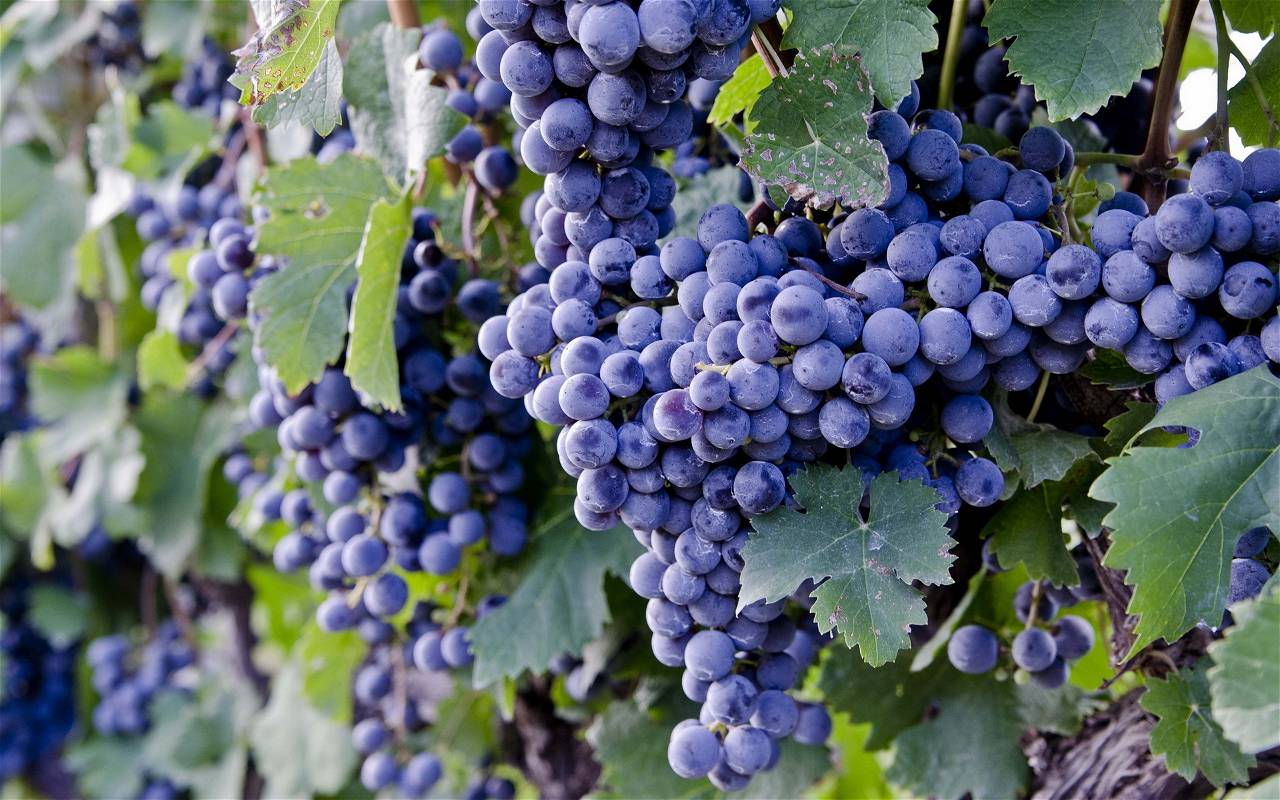
In Tamil Nadu, grapes are cultivated in an area of 2800 ha of which Theni district alone accounts for 2184 ha representing 78 percent to the total grape area in Tamil Nadu followed by Coimbatore district (9 percent) and Dindigul district (8 percent). In terms of production also, Theni district ranks first with a 76 percent share in the State's total production of grapes (29338 tonnes), followed by the Coimbatore district with 11 percent (4110 tonnes) and Dindigul district with 8 percent (3246 T).
Cumbum is located between the Thekkady Hills, Varusanadu Hills, and Kodaikanal. The region of Cumbum in Tamil Nadu is one of South India’s most fertile lands. The soil is blessed with rich nutrients and the climate is aptly suited for the cultivation of Grapes. The valley consists of large areas of farmland and includes crops like paddy, vegetables, grape vineyards, and banana and guava farms. Cumbum is referred to as ‘Green Valley of South India’ and is rightly called as the Grapes City. It is one of the few regions in Tamil Nadu that has thriving grape cultivation.
The climatic condition in Cumbum is purely tropical. The mean annual rainfall is 825 mm In terms of productivity, Coimbatore ranks first with 19.1 tonnes per ha followed by Dindigul district with 16.9 tonnes per ha (GoTN, Season and Crop Report, Triennium ending 2013). Though grapes cultivation is financially attractive, farmers are not interested to invest in it further because of high fluctuating price, disease infestation such as downy mildew and powdery mildew, pest infestation (Ramanan et al., 2012), high initial investment (Sumathi, lack of remunerative price (Vairam and Muniyandi, 2013), whereas the traders reported that there are no adequate infrastructure facilities like road, transport, and cold storage. Even then, the grape is one of the major fruit crops in Tamil Nadu due to its demand.The major grape varieties grown are Muscat Hamburg (Panneer) and Thompson Seedless. Recent days Manjari medika variety very popularize and increase the cultivating areas.
Theni district is one of the most important grapes producing regions in Tamil Nadu. Black Seed and Green Seedless varieties of grape are grown in this district. The district is an important source of supply of grape to Chennai, Tiruchirapalli, Bangalore, Mumbai, Kolkatta, throughout Kerala and various markets all over the India. The district's soil and climatic conditions are highly suitable for grape cultivation.
Similarly, to produce healthy and quality grape requires soluble fertilizers, growth hormones. These inputs are very costly and require heavy investments. For these reasons the grape cultivators might have expressed the problem of high cost of fertilizers, pesticides, soluble fertilizers and growth regulators. Quality of soil is another constraint because which determines the taste, colour, size, quality of agricultural produce. Shortage of water in the summer season are yet another technical constraint.
Financial constraints are very high rate of interest, non-availability of credit in time and inadequate credit support for expansion of area under grape, inadequate guidance on credit availability, high cost of production and lengthy and tedious procedure in advancing loan are the important credit constraints expressed by majority of grape cultivators in grape production and marketing. The present state of credit facility in general is not satisfactory as rate of interest is very high and also non-availability of credit in time, lengthy and tedious procedures in advancing loan. These causes are expressed by majority of grape growers.
GRAPE PACKAGE OF PRACTICES:
Major varieties are Muscat (Panneer), Pachadraksha, Anab-e-Shahi, Thompson Seedless, Arka Shyam, Arka Kanchan, Arka Hans, Manik Chaman, Sonaka, Sharadh Seedless and Flame Seedless are normally cultivated. Muscat is grown in Tamil Nadu where the rainfall is low to moderate.
Soil and climate: The crop performs best in well-drained rich loamy soil with a pH of 6.5 - 7.0 with low water table with EC less than 1.0. Soil depth should be at least 1 m.
Field preparation and planting: Trenches of 0.6 m width and 0.6 m depth are to be dug at a distance of 3 m apart for Muscat and pits of 1m x 1m x 1m should be dug for other varieties. Well-decomposed FYM or compost or green leaf manure has to be applied in the trenches or pits as the case may be and then covered with soil. Plant the rooted cuttings in June-July.
Spacing: The adopted spacing is 3 x 2 m for Muscat and 4 x 3 m for other varieties.
Irrigation: Irrigate immediately after planting and on the 3rd day and then once in a week. Withhold irrigation 15 days before pruning and also 15 days before harvest.
Training: The vines are trained with single stem upto pandal with a stalk on tipping at 2 m height. The main arms are developed and trained on opposite directions. On further tipping, secondary and tertiary arms are developed for spreading all over pandal.
Pruning: In general four bud level of pruning for Muscat, Pachadraksha, Bangalore Blue, Anab-e-Shahi and Arka hybrids and two bud level for Thompson Seedless may be adopted. It is better to decide the level of pruning as per bud forecasting technique. Weak and immature canes should be pruned to one or two buds to induce vegetative growth.
Pruning Season: Summer crop: Pruning is done in December – January and harvesting in April – May.
Monsoon crop: Pruning is done in May-June and harvesting in August-September.
Special practices: Tipping of shoots and tying of clusters in the pandal after the fruit set should be done. The tendrils have to be removed. Nip the growing shoots of axillary buds and terminal buds at 12 to 15 buds. Fruit thinning is done in compact bunches by removing 20 % of the berries at pea stage. Dip the clusters in solution containing Brassinosteroid 0.5 ppm and GA3 25 ppm at 10-12 days after fruit set to maintain vigour, yield and quality parameters.
Plant protection: Pests: Nematodes: 60 g of Carbofuran 3 G or Phorate 10 G granules per vine are applied a week before pruning and the plots are irrigated profusely. The soil should not be disturbed for atleast 15 days. Thereafter normal manuring may be done. Application of neemcake 200 g/vine also controls nematodes. Alternatively, application of Pseudomonas fluorescens formulation in talc containing 15 x 108 colony forming units/g, 30 cm away from base of the vine at least 15 cm depth at the time of pruning will also serve as a control measure.
Flea beetles: Spray Phosalone 35 EC (2ml/lit of water) after pruning and followed by two or three sprayings. The loose bark may be removed at the time of pruning to prevent egg laying.
Thrips: Spray Methyl demeton 25 EC or Dimethoate 30 EC @ 2 ml/lit of water to control thrips.
Mealy bug: Apply Quinalphos or Methyl parathion dust in the soil @ 20 kg/ha to kill the Phoretic ants. Spray Methyl demeton 25 EC or Monocrotophos 36 WSC @ 2 ml/lit of water or spray Dichlorvos 76 WSC @ 1 ml/lit with fish oil resin soap at 25 g/lit to control the pest. Release Coccinellid beetle, Cryptolaemus montrouzieri at the rate of 10 per vine.
Stem girdler: Swab the trunk with Carbaryl 50 WP @ 2 gm/lit to control the pest.
Diseases: Powdery mildew: Spray 0.3% Wettable sulphur or dust Sulphur @ 6-12 Kg/ha in the morning hours to control the fungus.
Anthracnose: Spray 1 % Bordeaux mixture or any other copper fungicide at 0.25 % concentration. Depending upon the weather conditions the number of sprays has to be increased.
Downy mildew: Spray 1 % Bordeaux mixture or any other copper fungicide at 0.25 % concentration. Depending upon the weather conditions the number of sprays has to be increased.
Ripening: To get uniform ripening in Muscat, spray the bunches with 0.2% Potassium sulphate (2 g/lit) at 20th day after berry set and another spray on 40th day. Dip the clusters of Thompson seedless and other seedless varieties at calyptra fall stage with 25 ppm GA (25 mg/lit) and repeat again at pepper stage to increase the length of berries.
Yield: Seedless : 15 t/ha/year, Muscat : 30 t/ha/year,Pachadraksha : 40 t/ha/year, Anab-e-Shahi and Arka hybrids : 20 t/ha/year
Grapes play a vital role in offering significant employment opportunity to millions of rural people in Theni district. Even though there is a lot of support from Research and Extension for grape cultivation, grapes cultivation has many problems and practical constraints. Based on the above point of view, Coca-Cola India and CENDECT KVK introduced a project UNNATI Grapes in Theni and Dindugal Districts. Main aim was maintenance of the world class demonstration orchards in an area of 5 hectares in CENDCET KVK farm itself. Improve farm productivity of grapes, leading to improvement in the income level of rural farmers and to alleviate poverty in the Project Area. To demonstrate innovative methods of cultivation which lead to higher productivity, lower operating cost and improved utilization of inputs including optimum utilisation of water and nutrients.
Introduction of new commercial varieties of grapes like Manjri Medika to the farmers for better realization. Train the farmers and create awareness on new cultivation practices which will improve the overall capability of the farmers for grape cultivation and Help farmers move to new root stocks (Dogridge) that are drought resistant and require less water, thereby decreasing the water usage and increasing the water efficiency, while simultaneously decreasing the risk of production. At the End of the GRAPE UNNATI project the Grape cultivating areas will be increased, chemicals free products, reduced the inputs cost, to produced a value added products from grapes, finally the farmers gain knowledge on recent technologies in grape cultivation and increased the grape productivity in double and farmer’s income also.












Share your comments